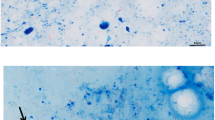Abstract
Acridine orange staining for the detection of mycobacteria was compared with staining by auramine 0 and with mycobacterial culture in a series of 1071 clinical specimens. A total of 78 (7 %) specimens were positive by staining. No false positive or negative findings were recorded by the acridine orange method. The two fluorochromes proved equal in their ability to detect mycobacteria in specimens from culture positive cases of tuberculosis. In the rapid bacteriological diagnosis of tuberculosis, acridine orange offers a good alternative to auramine 0 which is considered carcinogenic.
Similar content being viewed by others
References
Gangadharam, P. R.: The role of the laboratory in the management of tuberculosis patients. Seminars in Respiratory Medicine 1981, 2: 182–195.
International Agency for Research on Cancer: Monographs on the evaluation of carcinogenic risk of chemicals to humans. Chemicals and industrial processes associated with cancer in humans. Volumes 1 to 20, Supplement 1. IARC, Lyon, 1979, p. 24.
Ulber, H.: Schnellfärbung von Mykobakterien für den fluoreszenz-mikroskopischen Nachweis. Zeitschrift für Erkrankungen der Atmungsorgane 1970, 133: 462–464.
Kalich, R., Bennert, G., Fiedler, T., Kubin, M., Mezensky, L., Turzova, M., Ulber, H.: Comparison of auramine-rhodamine B and acridine orange for staining of acid-fast bacteria. Journal of Hygiene, Epidemiology, Microbiology and Immunology 1979, 23; 307–317.
Bartholomew, J. W.: Stains for micro-organisms in smears. In: Clark, G. (ed.): Staining procedures. Williams and Wilkins, Baltimore, 1980, p. 380–383.
Grosch, D. S.: Genetic poisons. In: Hodgson, E., Guthrie, F. E. (ed.): Introduction to biochemical toxicology. Blackwell New York, 1980, p. 302–303.
Heddle, J. A., Bruce, W. R.: Comparison of tests for mutagenicity or carcinogenicity using assays for sperm abnormalities, formation of micronuclei and mutations in salmonella. In: Hiatt, H. H., Watson, J. D., Winsten, J. A. (ed.): Origins of human cancer. Book C: Human risk assessment. Cold Spring Harbor Laboratory, Cold Spring, 1977, p. 1549–1557.
International Agency for Research on Cancer: Monographs on the evaluation of carcinogenic risk of chemicals to man. Some aromatic amines and related nitro compounds-hair dyes, colouring agents and miscellaneous industrial chemicals. Volume 16. IARC, Lyon, 1978, p. 145–152.
Clark, G. (ed.): Staining procedures. Williams and Wilkins, Baltimore, 1980.
Author information
Authors and Affiliations
Rights and permissions
About this article
Cite this article
Katila, M.L., Mäntyjärvi, R.A. Acridine orange staining of smears for demonstration ofMycobacterium tuberculosis . Eur. J, Clin. Microbiol. 1, 351–353 (1982). https://doi.org/10.1007/BF02019933
Issue Date:
DOI: https://doi.org/10.1007/BF02019933




